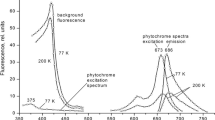Summary
Phytochrome-mediated anthocyanin synthesis of the mustard seedling (Sinapis alba L.) can be regarded as a prototype of a “positive” photoresponse. “Positive” photoresponses are those which are characterized by an initiation or an increase of biosynthetic or growth processes. The initial lag-phase of this type of photoresponse is relatively long. In the case of anthocyanin synthesis of the mustard seedling it takes about 3 hours after the initial formation of P730, the active phytochrome, until anthocyanin synthesis can be measured (Fig.). This period of time has been called initial (or primary) lag-phase.
In earlier papers (e.g. Lange and Mohr, 1965; Mohr, 1966a, b; Schopfer, 1967) we have advanced and supported the hypothesis that the positive photoresponses (in the above sense) of the mustard seedling can be explained by a differential gene activation through P730. Those genes of which the activity can be started or increased by P730 have been called potentially active genes (P730).
In order to verify this hypothesis further we have been trying to characterize the processes which occur during the initial lag-phase after the onset of continuous far-red light. There is good evidence (Hartmann, 1966; Clarkson and Hillman, 1967) that under continuous far-red a low but virtually stationary concentration of the active P730 can be maintained in the seedling's tissues over a period of many hours. Consequently we are dealing with steady state conditions of P730 when we investigate the process of anthocyanin accumulation under continuous far-red.
In the present paper we present data which indicate that P730 exerts two functions during the initial lag-phase. First, it eliminates a barrier before the potentially active genes insolfar as it makes these genes accessible for the activating action of P730. Secondly, P730 starts the activity of potentially active genes. To maintain gene activity the continuous presence of P730 is required. On the other hand, it a gene has once been “opened” to the action of P730 it remains easily accessible for the activating action of P730 even in the case when P730 disappeared and gene activity ceased for an extended period of time. After the re-appearance of P730 the gene can be activated almost immediately. These conclusions have been derived from the following facts.
-
1.
The initial lag-phase after the onset of far-red is always in the order of 3 hours (Fig.). If, however, a seedling which was preirradiated with 12 hours of far-red is kept in darkness for an extended period and is then re-irradiated with far-red no lag-phase for the action of the second irradiation can be found even when anthocyanin synthesis had already ceased during the preceding dark period (Fig.).
Zusammenfassung
Nach Erstbelichtung des Senfkeimlings mit Dauer-Dunkelrot zeigt die Anthocyansynthese, eine typische “positive Photomorphose”, eine mehrere Stunden währende lag-Phase. Bei einer Zweitbelichtung (Programm: Erstbelichtung — längere Dunkelperiode — Zweitbelichtung) fehlt die lag-Phase (Abb.). — Auch die Zweitbelichtung dürfte die Anthocyansynthese über eine Genaktivierung, die eine Enzymsynthese zur Folge hat, auslösen (Tabelle). — Die wichtigsten Konsequenzen: P730, das aktive Phytochrom, kann die Enzymsynthese sehr rasch bewirken, falls die Gene der Aktivierung durch P730 zugänglich sind. Die lange lag-Phase nach Einsetzen der Erstbelichtung benötigt das P730 offenbar dazu, die potentiell aktiven Gene (P730) für das P730 zugänglich zu machen. Die diesbezüglichen Änderungen, vermutlich in der Umgebung der Gene, bleiben auch dann erhalten, wenn P730 verschwindet. P730 scheint also zwei distinkte Funktionen zu haben, die man experimentell trennen kann: Es macht die Gene zugänglich und es aktiviert die betreffenden Gene.
Similar content being viewed by others
Literatur
Clarkson, D. T., and W. S. Hillman: Stability of phytochrome concentration in dicotyledonous tissues under continuous far-red light. Planta (Berl) 75, 286–290 (1967).
Durst, F., and H. Mohr: Half-life of phytochrome-induced phenylalanine deaminase in mustard seedlings (Sinapis alba L.). Naturwissenschaften 53, 707 (1966).
Fondeville, J. C., H. A. Borthwick, and S. B. Hendricks: Leaflet movement of Mimosa pudica L. indicative of phytochrome action. Planta (Berl.) 69, 359–364 (1966).
Hartmann, K. M.: A general hypothesis to interpret “high energy phenomena” of photomorphogenesis on the basis of phytochrome. Photochem. Photobiol. 5, 349–366 (1966).
Hillman, W. S., and W. L. Koukkari: Phytochrome effects in the nyctinastic leaf movements of Albizzia julibrissin and some other legumes. Plant Physiol. (in press) (1967).
Lange, H., u. H. Mohr: Die Hemmung der phytochrominduzierten Anthocyansynthese durch Actinomycin D und Puromycin. Planta (Berl.) 67, 107–121 (1965).
Mohr, H.: Untersuchungen zur phytochrominduzierten Photomorphogenese des Senfkeimlings (Sinapis alba L.). Z. Pflanzenphysiol. 54, 63–83 (1966a).
—: Differential gene activation as a mode of action of phytochrome 730. Photochem. Photobiol. 5, 469–483 (1966b).
—: Photomorphogenesis. In: The physiology of plant growth, development and responses (M. B. Wilkins, ed.). Maidenhead: McGraw-Hill Book Co 1967.
—: Experimente zur Wirkung von Actinomycin D auf die durch Phytochrom bewirkte Anthocyansynthese. Planta (Berl.) 75, 180–184 (1967).
—: Die Hemmung der phytochrom-induzierten Anthocyansynthese durch Puromycin und 2-Thiouracil. Planta (Berl.) 71, 195–203 (1966).
Schopfer, P.: Die Hemmung der phytochrominduzierten Photomorphogenese (“positive” Photomorphosen) des Senfkeimlings (Sinapis alba L.) durch Actinomycin D und Puromycin. Planta (Berl.) 72, 297–305 (1967).
Wagner, E., and H. Mohr: Kinetic studies to interpret “high-energy phenomena” of photomorphogenesis on the basis of phytochrome. Photochem. Photobiol. 5, 397–406 (1966a).
—: Kinetische Studien zur Interpretation der Wirkung von Sukzedanbestrahlungen mit Hellrot und Dunkelrot bei der Photomorphogenese (Anthocyansynthese bei Sinapis alba L.). Planta (Berl.) 70, 34–41 (1966b).
—: “Primäre” und “sekundäre” Differenzierung im Zusammenhang mit der Photomorphogenese von Keimpflanzen (Sinapis alba L.). Planta (Berl.) 71, 204–221 (1966c).
Author information
Authors and Affiliations
Rights and permissions
About this article
Cite this article
Lange, H., Bienger, I. & Mohr, H. Eine neue Beweisführung für die Hypothese einer differentiellen Genaktivierung durch Phytochrom 730. Planta 76, 359–366 (1967). https://doi.org/10.1007/BF00387541
Received:
Issue Date:
DOI: https://doi.org/10.1007/BF00387541




